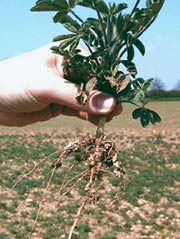Legume logic
 Legumes are a family of plants that form an association with soil bacteria of the genus Rhizobium for fixing atmospheric nitrogen in soils and plants. These plants, apart from providing protein-rich seeds for human consumption and forage for livestock, help improve soil fertility when plowed into the soil. Among the plants that belong to the legume family are peas, beans, grams, and forage crops such as sunhemp and alfalfa. Though the returns from legume grain crops were comparatively less, they had much more beneficial impact on the soil, hence played a vital role in sustaining soil fertility.
Legumes are a family of plants that form an association with soil bacteria of the genus Rhizobium for fixing atmospheric nitrogen in soils and plants. These plants, apart from providing protein-rich seeds for human consumption and forage for livestock, help improve soil fertility when plowed into the soil. Among the plants that belong to the legume family are peas, beans, grams, and forage crops such as sunhemp and alfalfa. Though the returns from legume grain crops were comparatively less, they had much more beneficial impact on the soil, hence played a vital role in sustaining soil fertility.
Though farmers across civilisations have been cultivating legumes, only in the late 1800s in Germany was it understood how bacteria growing in association with legumes could accomplish the remarkable task of collecting atmospheric nitrogen and making it available for other growing plants. For this, Rhizobium bacteria infect the root hairs of legume seedlings, causing the formation of a bump on the root, called nodule.
The plant and bacteria live in a symbiotic relation, in which both organisms benefit. The soil bacteria which live in the roots of legume plants benefit from the plant by getting a place to live and some nutrients from the plant. The plant benefits because the bacteria are able to take nitrogen from the air and transform it into a form that the plant can use for its own growth.
This ability to fix nitrogen allows the plant to meet its nitrogen needs even when soil nitrogen is limited. This mutually beneficial association is called nitrogen fixation. It happens because the bacteria help the nitrogen to chemically combine with hydrogen to form ammonia, and ultimately amino acids and plant protein. Legumes are vitally important in agriculture because of their high protein content and their independence of soil nitrogen resources. Nitrogen thus produced is returned to the soil in two ways; either as cattle dung after the livestock eat the forage or as green manure (which is plowed back to the soil without harvesting). The latter method has the capability to return more nitrogen to the soil.
Legumes have been an integral part of cropping patterns practised by Indian farmers, till very recently. As and when irrigation facilities became available in many areas where legumes were cultivated traditionally, farmers switched over to lucrative crops such as rice and sugarcane.
